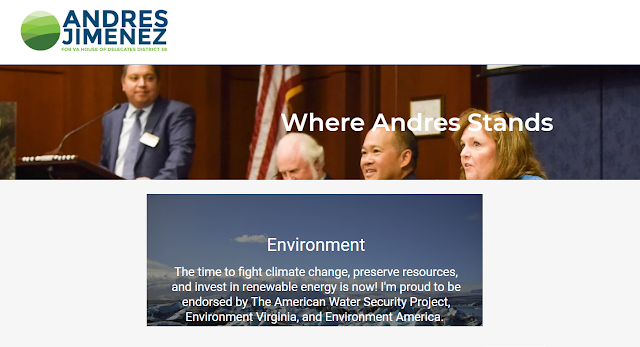Climate Change Is Real
In 2017, a survey showed that the percentage of Americans who believe that God created man in present form reached a low of 37 percent. In March of 2019, a poll showed one-third of Americans still do not believe global warming is caused by human activities. It is not surprising then that a study finds a significant association between those who deny evolution and those who deny climate change. It is indeed unfortunate to see substantial "antiscience" in a developed country like the United States. However, what is more alarming is that less than half are worried about climate change. And among those who are worried, very few are probably aware of what it would take to stop carbon dioxide emissions. Andres Jimenez, a candidate for the Virginia House of Delegates District 38, states that "The time to fight climate change, preserve resources, and invest in renewable energy is now!" And he is correct.
Whether it is doable or not, that is the question. Most of our carbon dioxide emissions come from power generation. Dominion Energy of Virginia, for instance, has the following mix:
Only 2% currently comes from renewable sources (solar and wind).
Climate change is not just real. It is going to happen soon enough even for my generation to see. There is a real urgency. Solutions, however, require a massive change since we are currently trapped in a centralized infrastructure that will simply continue to emit carbon dioxide into the atmosphere. The choice does not really sit on an individual basis. The choice is in the political arena.
Dan Nyocera from Harvard University recently gave a talk to our department and in the following slide, he reminded us of what lies in the future:
These numbers are real and this is what we are up against. "The time to fight climate change, preserve resources, and invest in renewable energy is now!" And we need our leaders to do all of these now.
 |
| Above copied from Virginia38.com |
Whether it is doable or not, that is the question. Most of our carbon dioxide emissions come from power generation. Dominion Energy of Virginia, for instance, has the following mix:
 |
| Above copied from 2018 Integrated Resource Plan Dominion Power |
Only 2% currently comes from renewable sources (solar and wind).
Climate change is not just real. It is going to happen soon enough even for my generation to see. There is a real urgency. Solutions, however, require a massive change since we are currently trapped in a centralized infrastructure that will simply continue to emit carbon dioxide into the atmosphere. The choice does not really sit on an individual basis. The choice is in the political arena.
Dan Nyocera from Harvard University recently gave a talk to our department and in the following slide, he reminded us of what lies in the future:
These numbers are real and this is what we are up against. "The time to fight climate change, preserve resources, and invest in renewable energy is now!" And we need our leaders to do all of these now.

Factoring the effects of climate change into real estate investments
ReplyDeleteFor real estate owners and developers, being underwater has long been metaphoric shorthand for stressful times, when property debt exceeds property value, or expenses exceed income. But the term now has new meaning: Real estate property could actually be underwater because of future climate change.
Hardly a day goes by without yet another report, editorial commentary or prediction about climate change and its risks, evidenced convincingly by countless scientific studies. Observable, measurable evidence includes increasing ocean and land temperatures; weather patterns and weather-related events of abnormal frequency and intensity such as hurricanes, flooding and wildfires; changing biosphere patterns; accelerating glacial melting at the poles and extreme northern and southern latitudes; and rising sea level.
But you don’t need to be a scientist to understand that economic and physical climate change effects could adversely affect real estate. Risks exist at all geographic scales and places: along seacoasts; within watersheds; on hillsides; and in vulnerable urban, suburban and exurban areas. Individual buildings likewise are at risk, depending on their location and construction.
Among recent reports worth reading is “Climate Risk and Real Estate Investment Decision-Making,” published by the Urban Land Institute (ULI) and Heitman, a real estate investment management firm. This is truly one report that President Trump — real estate developer, investor and owner — might actually want to read. Fundamentally about money, it identifies sources and impacts of “physical” risks and of “transition” risks associated with climate change.
Physical risks are those caused directly by specific catastrophic events — hurricanes, sea level rise, drought, wildfires — that are ultimately attributable to climate change and shifting weather patterns. Among the many negative impacts of such events are greatly increased cost of maintaining, repairing and reconstructing seriously damaged or destroyed structures; soaring costs of property insurance; and post-event business and economic productivity losses.
Source: property listing cebu